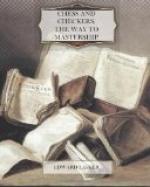The correct way of maneuvering for White will be to confine Black’s King to a smaller and smaller territory until he finally has to back up against the side or the corner of the board. This consideration indicates the following line of play:
(1)Q-f5, K-c6; (2)Q-e5, K-d7; (3) K-c4, K-c6; (4) Q-e7, K-b6; (5) Q-d7, K-a6. White must now be very careful to avoid a stalemate which would result if he deprived the King of all mobility without attacking him at the same time. This would be the case if he now moved Q-c7. For then Black could not move the King to b5, as this square is controlled by White’s King, and he could not go to any of the other four squares in his range on account of White’s Queen attacking all of them. The correct move is (6) K-c5. This leaves only the square a5 for Black’s King, and White checkmates by (7) Q-a7 or (7) Q-b5.
If, in Diagram 9, White had a Rook on h3 instead of the Queen, the mating process would take a few more moves, but there would be no escape for Black either.
It will again be White’s aim to confine Black’s King to a smaller and smaller number of squares. The best way to start will therefore be (1) R-e3. No matter what Black replies, he cannot prevent White from driving him to the edge of the board in a similar way to the one shown in the following example:
(1) ..., K-d5; (2) R-e1. This is a waiting move. Black must leave d5, thus enabling either White’s King to advance or the Rook to occupy e5. (2) ..., K-c5; (3) R-e5; K-d6; (4) K-d4, K-c6; (5) R-d5, K-b6; (6) R-c5, K-b7; (7) K-d5, K-b6; (8) K-d6, K-b7; (9) R-b5, K-a6; (10) K-c6, K-a7; (11) K-c7, K-a6; (12) R-h5, K-a7; (13) R-a5 mate.
The two examples discussed show that it is not necessary to drive the King into the corner but that he can be mated on any square of the edge by Queen or Rook. It will be observed that in the mating position three of the six squares at Black’s disposal are controlled by White’s King and the other three by the Rook (or the Queen). If White had only a Bishop or a Knight in addition to the King he could never mate Black, for neither Bishop nor Knight can attack the King and at the same time control a square adjacent to the King. This, however, is at least necessary to force the mate, even in the most unfavorable position of the King, that is, in the corner.
+---------------------------------------+ 8 | | | | | | | | | |---------------------------------------| 7 | | | | | | | | | |---------------------------------------| 6 | ^Kt| | | | | | | | |---------------------------------------| 5 | | | | | | | | | |---------------------------------------| 4 | | | | | | | | | |---------------------------------------| 3 | | | | | | | | #P | |---------------------------------------| 2 | | | | | | ^K | | #K | |---------------------------------------| 1 | | | | | | | | | +---------------------------------------+ a b c d e f g h
Diagram 10.




